Financial Reporting Analysis: Vinmart's Regulatory Framework & Goals
VerifiedAdded on 2021/06/01
|7
|1957
|92
Report
AI Summary
This report provides a comprehensive analysis of Vinmart's financial reporting practices. It begins by examining the regulatory framework governing financial reporting, including the roles of the Land Law (Company Act), reporting standards (IAS/IFRS), and the IASB's Conceptual Framework. The report then explores the context of financial reporting, encompassing company legislation (The Companies Act 2006), accounting standards (IFRS and GAAP), and corporate governance principles. The analysis further delves into the value of financial reporting in meeting Vinmart's goals, specifically focusing on the cash flow statement, balance sheet, and income statement, and how these statements help achieve the company's objectives. Finally, the report identifies key stakeholders, their information needs, and how financial reporting satisfies these needs, including managers, employees, suppliers, and investors, highlighting the specific information each group requires from financial statements to make informed decisions. The report emphasizes the importance of financial reporting in assessing a company's performance, financial position, and future prospects.
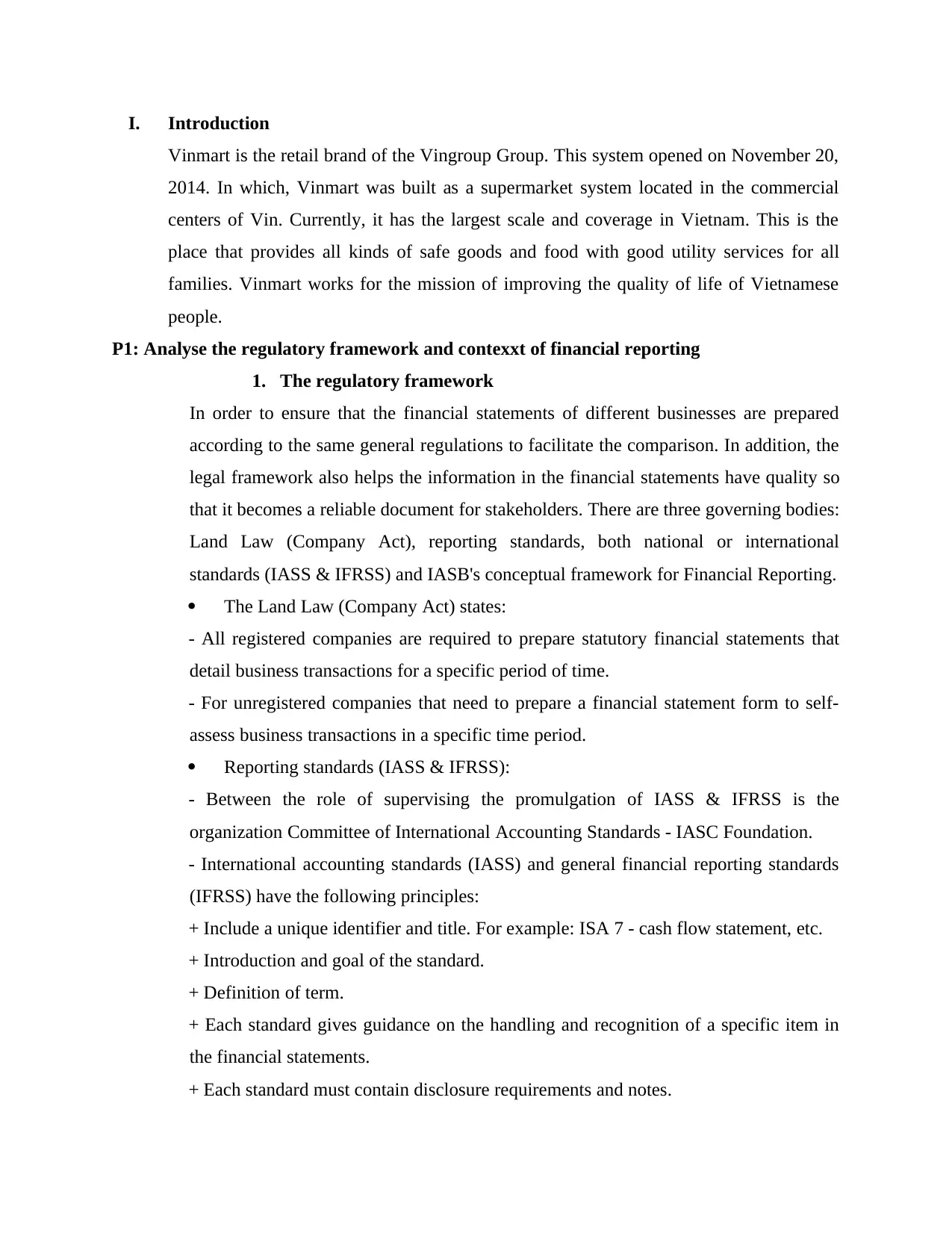
I. Introduction
Vinmart is the retail brand of the Vingroup Group. This system opened on November 20,
2014. In which, Vinmart was built as a supermarket system located in the commercial
centers of Vin. Currently, it has the largest scale and coverage in Vietnam. This is the
place that provides all kinds of safe goods and food with good utility services for all
families. Vinmart works for the mission of improving the quality of life of Vietnamese
people.
P1: Analyse the regulatory framework and contexxt of financial reporting
1. The regulatory framework
In order to ensure that the financial statements of different businesses are prepared
according to the same general regulations to facilitate the comparison. In addition, the
legal framework also helps the information in the financial statements have quality so
that it becomes a reliable document for stakeholders. There are three governing bodies:
Land Law (Company Act), reporting standards, both national or international
standards (IASS & IFRSS) and IASB's conceptual framework for Financial Reporting.
The Land Law (Company Act) states:
- All registered companies are required to prepare statutory financial statements that
detail business transactions for a specific period of time.
- For unregistered companies that need to prepare a financial statement form to self-
assess business transactions in a specific time period.
Reporting standards (IASS & IFRSS):
- Between the role of supervising the promulgation of IASS & IFRSS is the
organization Committee of International Accounting Standards - IASC Foundation.
- International accounting standards (IASS) and general financial reporting standards
(IFRSS) have the following principles:
+ Include a unique identifier and title. For example: ISA 7 - cash flow statement, etc.
+ Introduction and goal of the standard.
+ Definition of term.
+ Each standard gives guidance on the handling and recognition of a specific item in
the financial statements.
+ Each standard must contain disclosure requirements and notes.
Vinmart is the retail brand of the Vingroup Group. This system opened on November 20,
2014. In which, Vinmart was built as a supermarket system located in the commercial
centers of Vin. Currently, it has the largest scale and coverage in Vietnam. This is the
place that provides all kinds of safe goods and food with good utility services for all
families. Vinmart works for the mission of improving the quality of life of Vietnamese
people.
P1: Analyse the regulatory framework and contexxt of financial reporting
1. The regulatory framework
In order to ensure that the financial statements of different businesses are prepared
according to the same general regulations to facilitate the comparison. In addition, the
legal framework also helps the information in the financial statements have quality so
that it becomes a reliable document for stakeholders. There are three governing bodies:
Land Law (Company Act), reporting standards, both national or international
standards (IASS & IFRSS) and IASB's conceptual framework for Financial Reporting.
The Land Law (Company Act) states:
- All registered companies are required to prepare statutory financial statements that
detail business transactions for a specific period of time.
- For unregistered companies that need to prepare a financial statement form to self-
assess business transactions in a specific time period.
Reporting standards (IASS & IFRSS):
- Between the role of supervising the promulgation of IASS & IFRSS is the
organization Committee of International Accounting Standards - IASC Foundation.
- International accounting standards (IASS) and general financial reporting standards
(IFRSS) have the following principles:
+ Include a unique identifier and title. For example: ISA 7 - cash flow statement, etc.
+ Introduction and goal of the standard.
+ Definition of term.
+ Each standard gives guidance on the handling and recognition of a specific item in
the financial statements.
+ Each standard must contain disclosure requirements and notes.
Paraphrase This Document
Need a fresh take? Get an instant paraphrase of this document with our AI Paraphraser
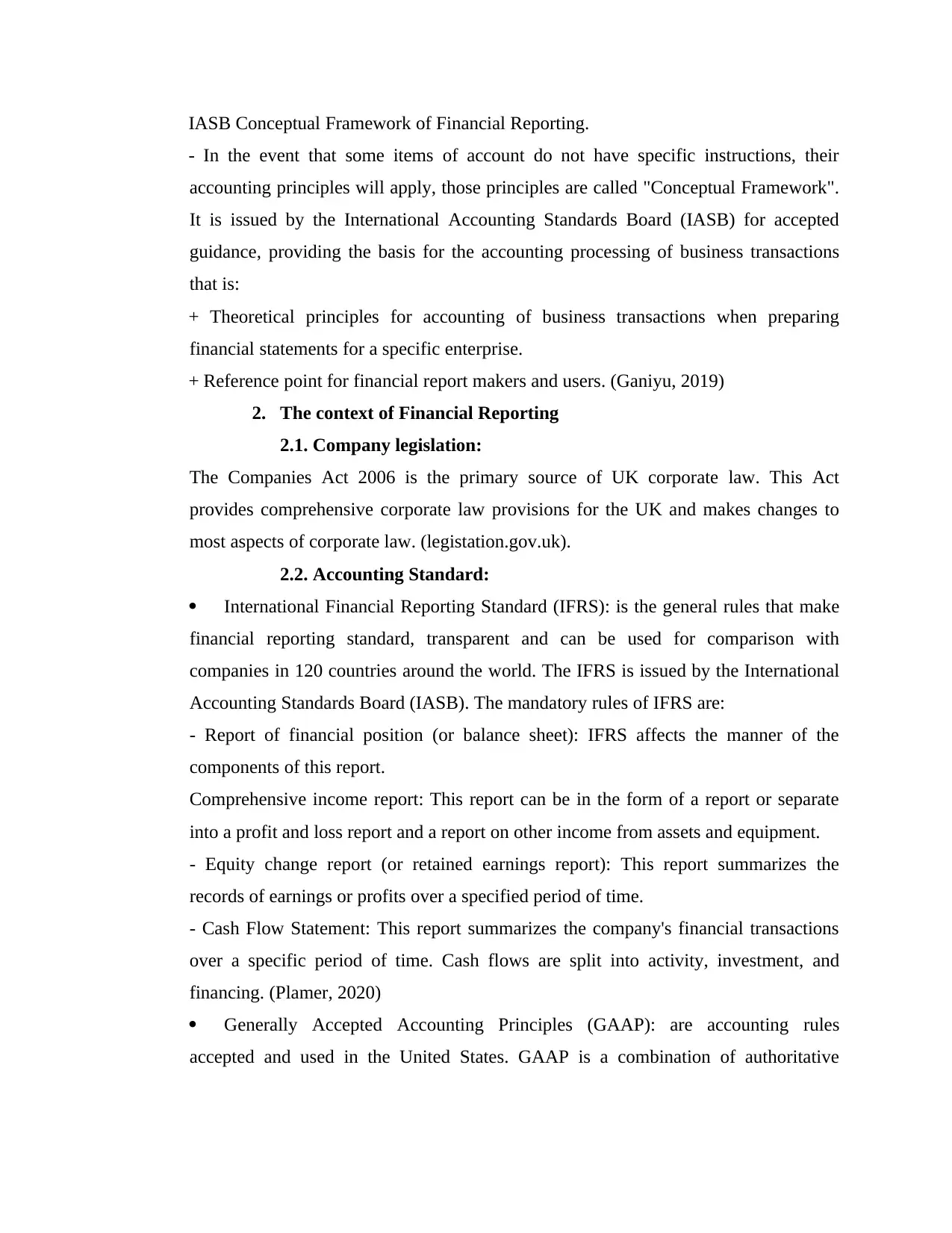
IASB Conceptual Framework of Financial Reporting.
- In the event that some items of account do not have specific instructions, their
accounting principles will apply, those principles are called "Conceptual Framework".
It is issued by the International Accounting Standards Board (IASB) for accepted
guidance, providing the basis for the accounting processing of business transactions
that is:
+ Theoretical principles for accounting of business transactions when preparing
financial statements for a specific enterprise.
+ Reference point for financial report makers and users. (Ganiyu, 2019)
2. The context of Financial Reporting
2.1. Company legislation:
The Companies Act 2006 is the primary source of UK corporate law. This Act
provides comprehensive corporate law provisions for the UK and makes changes to
most aspects of corporate law. (legistation.gov.uk).
2.2. Accounting Standard:
International Financial Reporting Standard (IFRS): is the general rules that make
financial reporting standard, transparent and can be used for comparison with
companies in 120 countries around the world. The IFRS is issued by the International
Accounting Standards Board (IASB). The mandatory rules of IFRS are:
- Report of financial position (or balance sheet): IFRS affects the manner of the
components of this report.
Comprehensive income report: This report can be in the form of a report or separate
into a profit and loss report and a report on other income from assets and equipment.
- Equity change report (or retained earnings report): This report summarizes the
records of earnings or profits over a specified period of time.
- Cash Flow Statement: This report summarizes the company's financial transactions
over a specific period of time. Cash flows are split into activity, investment, and
financing. (Plamer, 2020)
Generally Accepted Accounting Principles (GAAP): are accounting rules
accepted and used in the United States. GAAP is a combination of authoritative
- In the event that some items of account do not have specific instructions, their
accounting principles will apply, those principles are called "Conceptual Framework".
It is issued by the International Accounting Standards Board (IASB) for accepted
guidance, providing the basis for the accounting processing of business transactions
that is:
+ Theoretical principles for accounting of business transactions when preparing
financial statements for a specific enterprise.
+ Reference point for financial report makers and users. (Ganiyu, 2019)
2. The context of Financial Reporting
2.1. Company legislation:
The Companies Act 2006 is the primary source of UK corporate law. This Act
provides comprehensive corporate law provisions for the UK and makes changes to
most aspects of corporate law. (legistation.gov.uk).
2.2. Accounting Standard:
International Financial Reporting Standard (IFRS): is the general rules that make
financial reporting standard, transparent and can be used for comparison with
companies in 120 countries around the world. The IFRS is issued by the International
Accounting Standards Board (IASB). The mandatory rules of IFRS are:
- Report of financial position (or balance sheet): IFRS affects the manner of the
components of this report.
Comprehensive income report: This report can be in the form of a report or separate
into a profit and loss report and a report on other income from assets and equipment.
- Equity change report (or retained earnings report): This report summarizes the
records of earnings or profits over a specified period of time.
- Cash Flow Statement: This report summarizes the company's financial transactions
over a specific period of time. Cash flows are split into activity, investment, and
financing. (Plamer, 2020)
Generally Accepted Accounting Principles (GAAP): are accounting rules
accepted and used in the United States. GAAP is a combination of authoritative
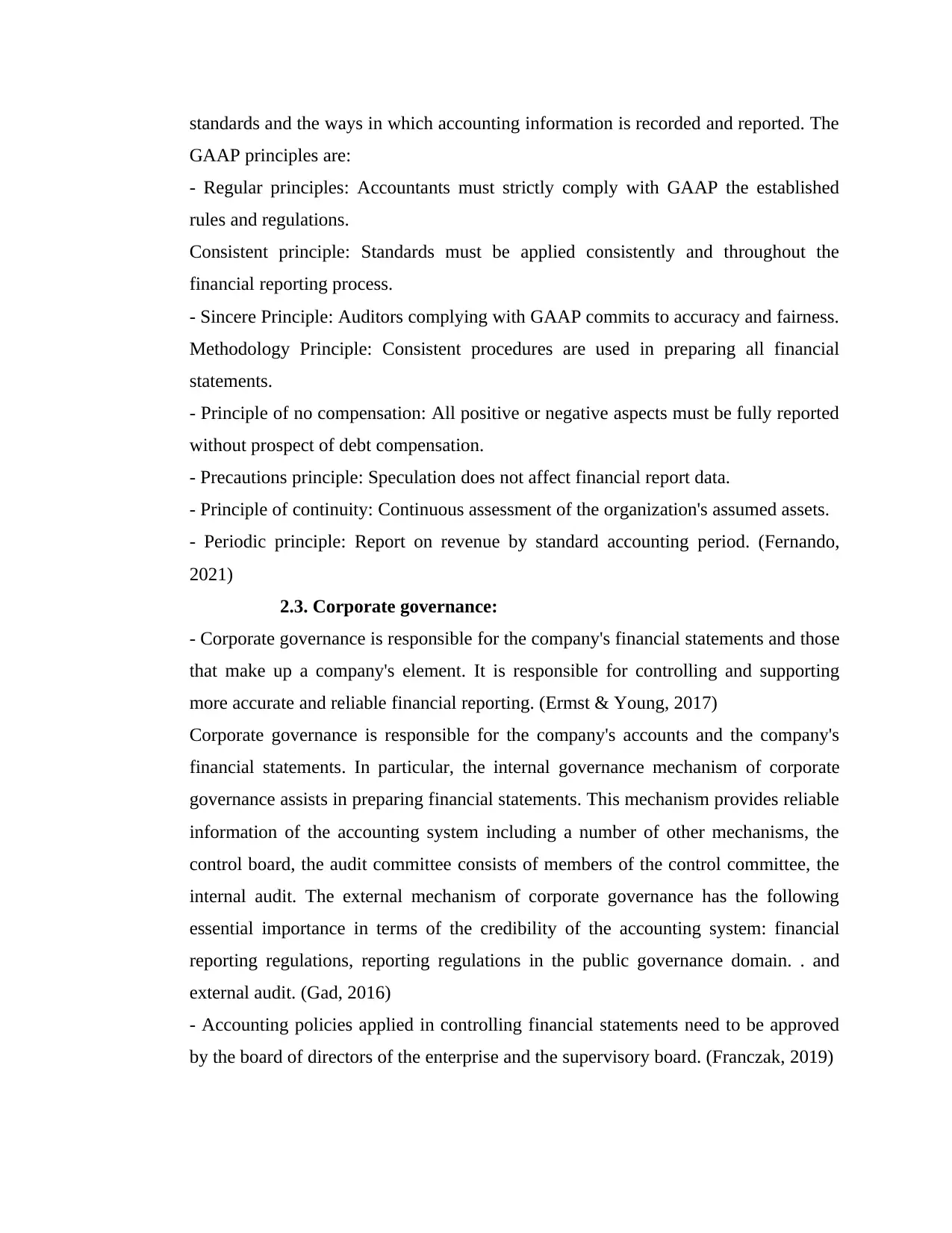
standards and the ways in which accounting information is recorded and reported. The
GAAP principles are:
- Regular principles: Accountants must strictly comply with GAAP the established
rules and regulations.
Consistent principle: Standards must be applied consistently and throughout the
financial reporting process.
- Sincere Principle: Auditors complying with GAAP commits to accuracy and fairness.
Methodology Principle: Consistent procedures are used in preparing all financial
statements.
- Principle of no compensation: All positive or negative aspects must be fully reported
without prospect of debt compensation.
- Precautions principle: Speculation does not affect financial report data.
- Principle of continuity: Continuous assessment of the organization's assumed assets.
- Periodic principle: Report on revenue by standard accounting period. (Fernando,
2021)
2.3. Corporate governance:
- Corporate governance is responsible for the company's financial statements and those
that make up a company's element. It is responsible for controlling and supporting
more accurate and reliable financial reporting. (Ermst & Young, 2017)
Corporate governance is responsible for the company's accounts and the company's
financial statements. In particular, the internal governance mechanism of corporate
governance assists in preparing financial statements. This mechanism provides reliable
information of the accounting system including a number of other mechanisms, the
control board, the audit committee consists of members of the control committee, the
internal audit. The external mechanism of corporate governance has the following
essential importance in terms of the credibility of the accounting system: financial
reporting regulations, reporting regulations in the public governance domain. . and
external audit. (Gad, 2016)
- Accounting policies applied in controlling financial statements need to be approved
by the board of directors of the enterprise and the supervisory board. (Franczak, 2019)
GAAP principles are:
- Regular principles: Accountants must strictly comply with GAAP the established
rules and regulations.
Consistent principle: Standards must be applied consistently and throughout the
financial reporting process.
- Sincere Principle: Auditors complying with GAAP commits to accuracy and fairness.
Methodology Principle: Consistent procedures are used in preparing all financial
statements.
- Principle of no compensation: All positive or negative aspects must be fully reported
without prospect of debt compensation.
- Precautions principle: Speculation does not affect financial report data.
- Principle of continuity: Continuous assessment of the organization's assumed assets.
- Periodic principle: Report on revenue by standard accounting period. (Fernando,
2021)
2.3. Corporate governance:
- Corporate governance is responsible for the company's financial statements and those
that make up a company's element. It is responsible for controlling and supporting
more accurate and reliable financial reporting. (Ermst & Young, 2017)
Corporate governance is responsible for the company's accounts and the company's
financial statements. In particular, the internal governance mechanism of corporate
governance assists in preparing financial statements. This mechanism provides reliable
information of the accounting system including a number of other mechanisms, the
control board, the audit committee consists of members of the control committee, the
internal audit. The external mechanism of corporate governance has the following
essential importance in terms of the credibility of the accounting system: financial
reporting regulations, reporting regulations in the public governance domain. . and
external audit. (Gad, 2016)
- Accounting policies applied in controlling financial statements need to be approved
by the board of directors of the enterprise and the supervisory board. (Franczak, 2019)
⊘ This is a preview!⊘
Do you want full access?
Subscribe today to unlock all pages.

Trusted by 1+ million students worldwide
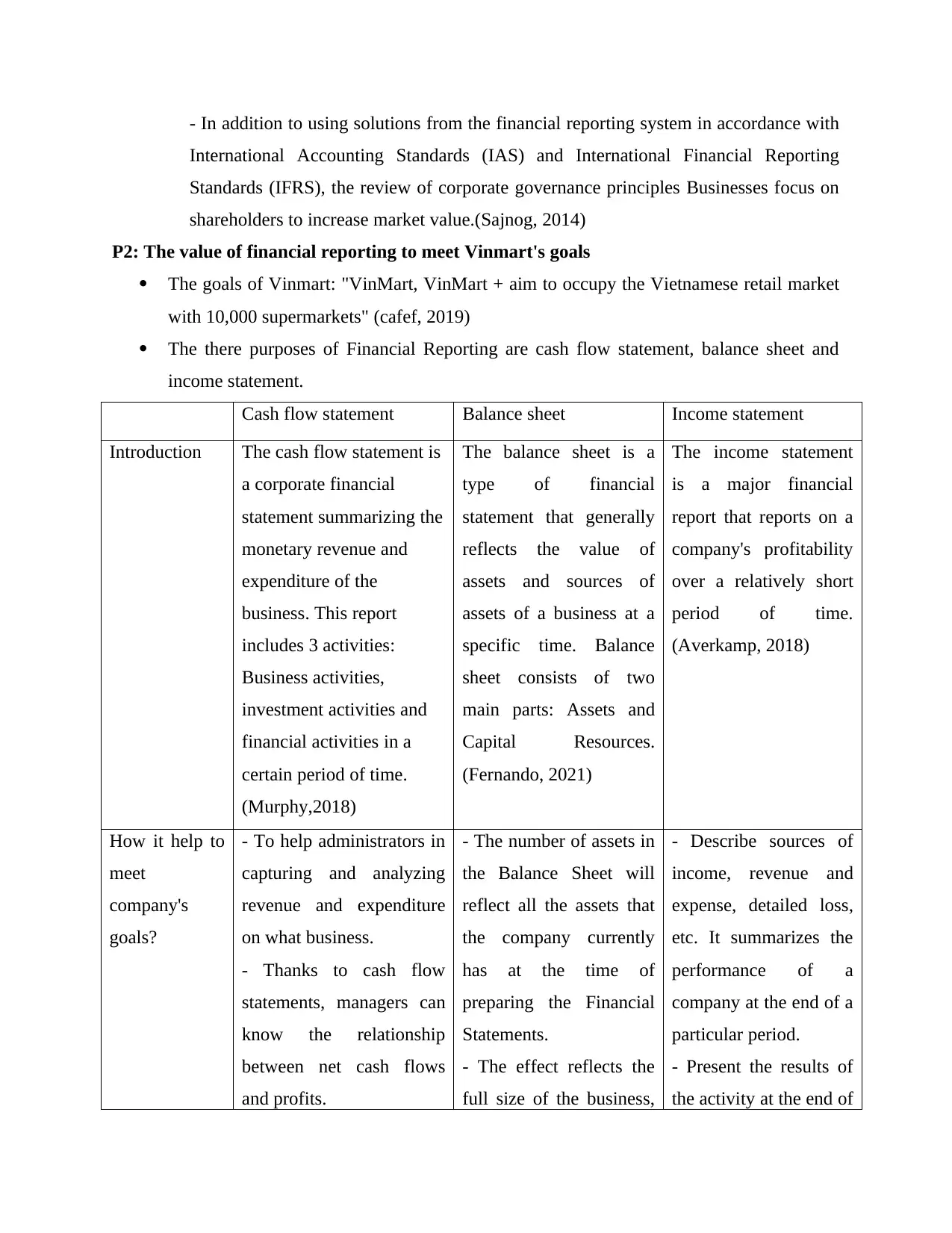
- In addition to using solutions from the financial reporting system in accordance with
International Accounting Standards (IAS) and International Financial Reporting
Standards (IFRS), the review of corporate governance principles Businesses focus on
shareholders to increase market value.(Sajnog, 2014)
P2: The value of financial reporting to meet Vinmart's goals
The goals of Vinmart: "VinMart, VinMart + aim to occupy the Vietnamese retail market
with 10,000 supermarkets" (cafef, 2019)
The there purposes of Financial Reporting are cash flow statement, balance sheet and
income statement.
Cash flow statement Balance sheet Income statement
Introduction The cash flow statement is
a corporate financial
statement summarizing the
monetary revenue and
expenditure of the
business. This report
includes 3 activities:
Business activities,
investment activities and
financial activities in a
certain period of time.
(Murphy,2018)
The balance sheet is a
type of financial
statement that generally
reflects the value of
assets and sources of
assets of a business at a
specific time. Balance
sheet consists of two
main parts: Assets and
Capital Resources.
(Fernando, 2021)
The income statement
is a major financial
report that reports on a
company's profitability
over a relatively short
period of time.
(Averkamp, 2018)
How it help to
meet
company's
goals?
- To help administrators in
capturing and analyzing
revenue and expenditure
on what business.
- Thanks to cash flow
statements, managers can
know the relationship
between net cash flows
and profits.
- The number of assets in
the Balance Sheet will
reflect all the assets that
the company currently
has at the time of
preparing the Financial
Statements.
- The effect reflects the
full size of the business,
- Describe sources of
income, revenue and
expense, detailed loss,
etc. It summarizes the
performance of a
company at the end of a
particular period.
- Present the results of
the activity at the end of
International Accounting Standards (IAS) and International Financial Reporting
Standards (IFRS), the review of corporate governance principles Businesses focus on
shareholders to increase market value.(Sajnog, 2014)
P2: The value of financial reporting to meet Vinmart's goals
The goals of Vinmart: "VinMart, VinMart + aim to occupy the Vietnamese retail market
with 10,000 supermarkets" (cafef, 2019)
The there purposes of Financial Reporting are cash flow statement, balance sheet and
income statement.
Cash flow statement Balance sheet Income statement
Introduction The cash flow statement is
a corporate financial
statement summarizing the
monetary revenue and
expenditure of the
business. This report
includes 3 activities:
Business activities,
investment activities and
financial activities in a
certain period of time.
(Murphy,2018)
The balance sheet is a
type of financial
statement that generally
reflects the value of
assets and sources of
assets of a business at a
specific time. Balance
sheet consists of two
main parts: Assets and
Capital Resources.
(Fernando, 2021)
The income statement
is a major financial
report that reports on a
company's profitability
over a relatively short
period of time.
(Averkamp, 2018)
How it help to
meet
company's
goals?
- To help administrators in
capturing and analyzing
revenue and expenditure
on what business.
- Thanks to cash flow
statements, managers can
know the relationship
between net cash flows
and profits.
- The number of assets in
the Balance Sheet will
reflect all the assets that
the company currently
has at the time of
preparing the Financial
Statements.
- The effect reflects the
full size of the business,
- Describe sources of
income, revenue and
expense, detailed loss,
etc. It summarizes the
performance of a
company at the end of a
particular period.
- Present the results of
the activity at the end of
Paraphrase This Document
Need a fresh take? Get an instant paraphrase of this document with our AI Paraphraser
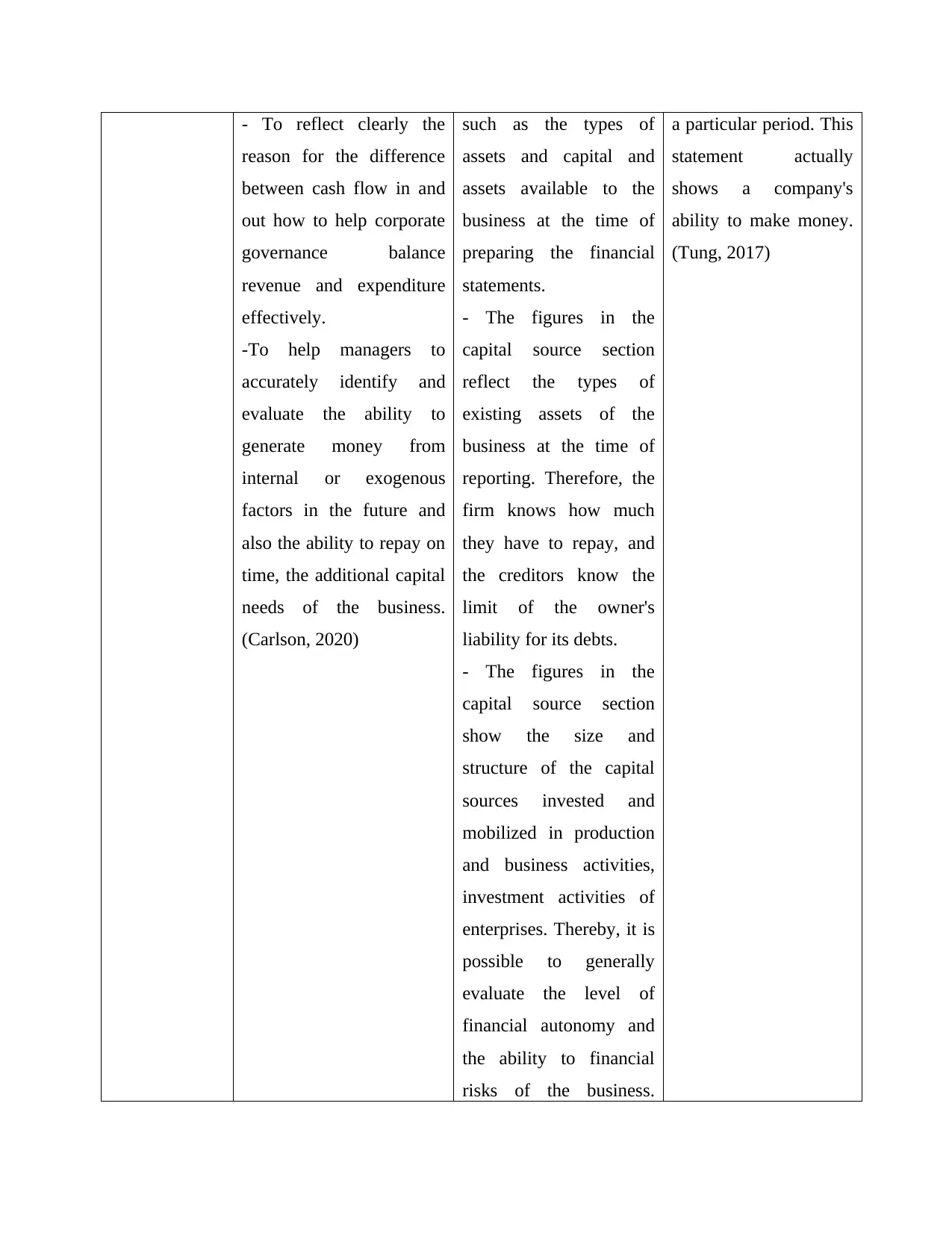
- To reflect clearly the
reason for the difference
between cash flow in and
out how to help corporate
governance balance
revenue and expenditure
effectively.
-To help managers to
accurately identify and
evaluate the ability to
generate money from
internal or exogenous
factors in the future and
also the ability to repay on
time, the additional capital
needs of the business.
(Carlson, 2020)
such as the types of
assets and capital and
assets available to the
business at the time of
preparing the financial
statements.
- The figures in the
capital source section
reflect the types of
existing assets of the
business at the time of
reporting. Therefore, the
firm knows how much
they have to repay, and
the creditors know the
limit of the owner's
liability for its debts.
- The figures in the
capital source section
show the size and
structure of the capital
sources invested and
mobilized in production
and business activities,
investment activities of
enterprises. Thereby, it is
possible to generally
evaluate the level of
financial autonomy and
the ability to financial
risks of the business.
a particular period. This
statement actually
shows a company's
ability to make money.
(Tung, 2017)
reason for the difference
between cash flow in and
out how to help corporate
governance balance
revenue and expenditure
effectively.
-To help managers to
accurately identify and
evaluate the ability to
generate money from
internal or exogenous
factors in the future and
also the ability to repay on
time, the additional capital
needs of the business.
(Carlson, 2020)
such as the types of
assets and capital and
assets available to the
business at the time of
preparing the financial
statements.
- The figures in the
capital source section
reflect the types of
existing assets of the
business at the time of
reporting. Therefore, the
firm knows how much
they have to repay, and
the creditors know the
limit of the owner's
liability for its debts.
- The figures in the
capital source section
show the size and
structure of the capital
sources invested and
mobilized in production
and business activities,
investment activities of
enterprises. Thereby, it is
possible to generally
evaluate the level of
financial autonomy and
the ability to financial
risks of the business.
a particular period. This
statement actually
shows a company's
ability to make money.
(Tung, 2017)
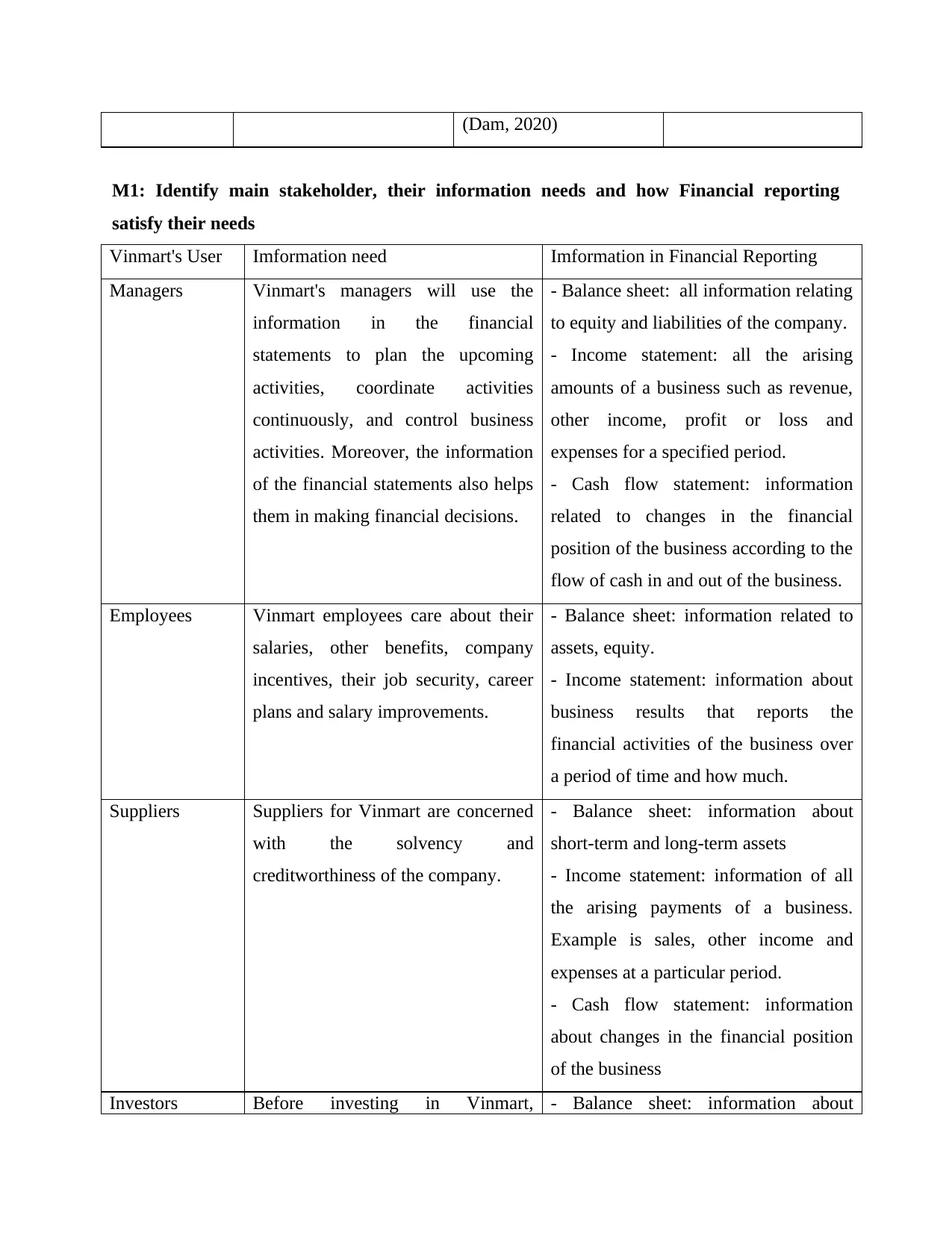
(Dam, 2020)
M1: Identify main stakeholder, their information needs and how Financial reporting
satisfy their needs
Vinmart's User Imformation need Imformation in Financial Reporting
Managers Vinmart's managers will use the
information in the financial
statements to plan the upcoming
activities, coordinate activities
continuously, and control business
activities. Moreover, the information
of the financial statements also helps
them in making financial decisions.
- Balance sheet: all information relating
to equity and liabilities of the company.
- Income statement: all the arising
amounts of a business such as revenue,
other income, profit or loss and
expenses for a specified period.
- Cash flow statement: information
related to changes in the financial
position of the business according to the
flow of cash in and out of the business.
Employees Vinmart employees care about their
salaries, other benefits, company
incentives, their job security, career
plans and salary improvements.
- Balance sheet: information related to
assets, equity.
- Income statement: information about
business results that reports the
financial activities of the business over
a period of time and how much.
Suppliers Suppliers for Vinmart are concerned
with the solvency and
creditworthiness of the company.
- Balance sheet: information about
short-term and long-term assets
- Income statement: information of all
the arising payments of a business.
Example is sales, other income and
expenses at a particular period.
- Cash flow statement: information
about changes in the financial position
of the business
Investors Before investing in Vinmart, - Balance sheet: information about
M1: Identify main stakeholder, their information needs and how Financial reporting
satisfy their needs
Vinmart's User Imformation need Imformation in Financial Reporting
Managers Vinmart's managers will use the
information in the financial
statements to plan the upcoming
activities, coordinate activities
continuously, and control business
activities. Moreover, the information
of the financial statements also helps
them in making financial decisions.
- Balance sheet: all information relating
to equity and liabilities of the company.
- Income statement: all the arising
amounts of a business such as revenue,
other income, profit or loss and
expenses for a specified period.
- Cash flow statement: information
related to changes in the financial
position of the business according to the
flow of cash in and out of the business.
Employees Vinmart employees care about their
salaries, other benefits, company
incentives, their job security, career
plans and salary improvements.
- Balance sheet: information related to
assets, equity.
- Income statement: information about
business results that reports the
financial activities of the business over
a period of time and how much.
Suppliers Suppliers for Vinmart are concerned
with the solvency and
creditworthiness of the company.
- Balance sheet: information about
short-term and long-term assets
- Income statement: information of all
the arising payments of a business.
Example is sales, other income and
expenses at a particular period.
- Cash flow statement: information
about changes in the financial position
of the business
Investors Before investing in Vinmart, - Balance sheet: information about
⊘ This is a preview!⊘
Do you want full access?
Subscribe today to unlock all pages.

Trusted by 1+ million students worldwide
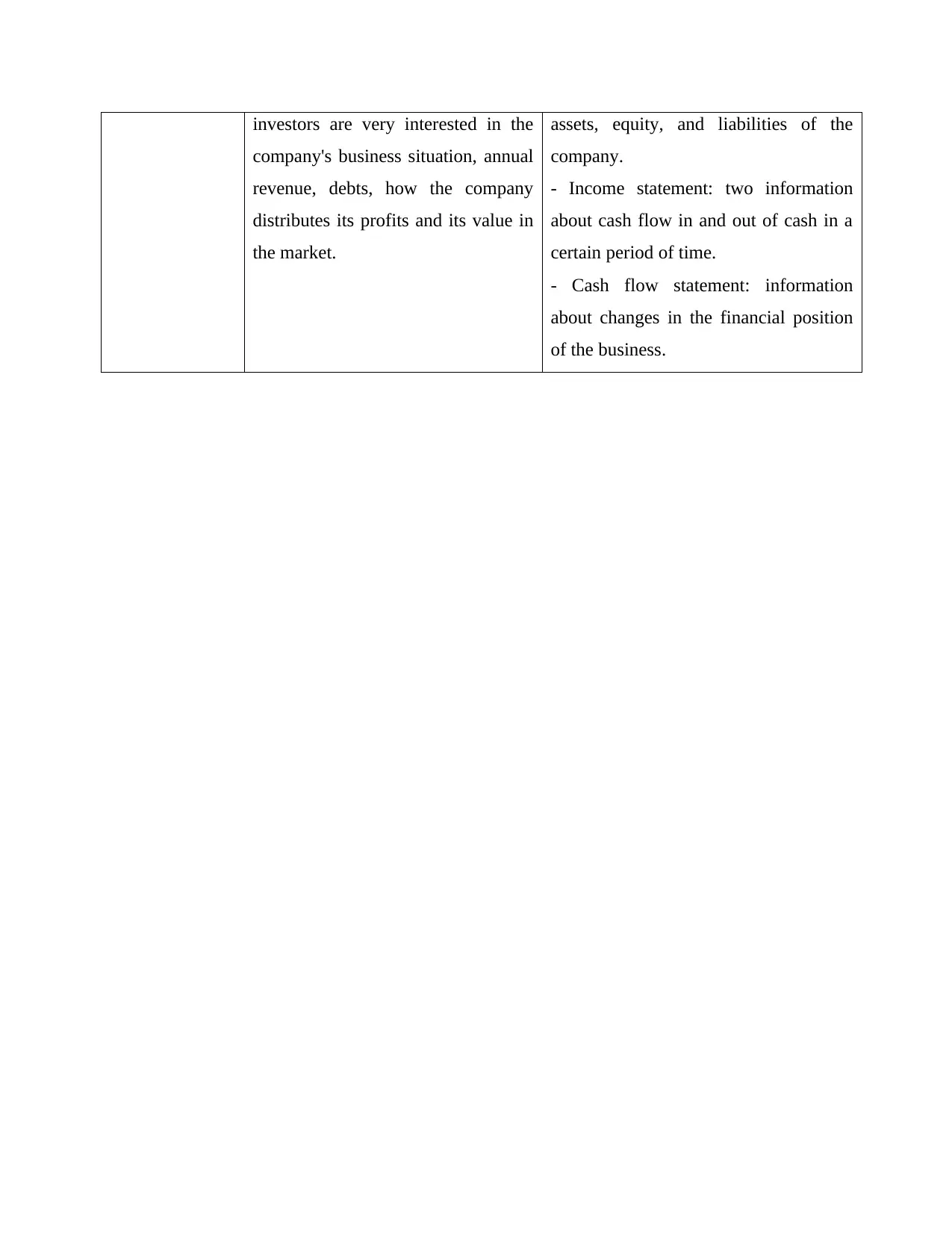
investors are very interested in the
company's business situation, annual
revenue, debts, how the company
distributes its profits and its value in
the market.
assets, equity, and liabilities of the
company.
- Income statement: two information
about cash flow in and out of cash in a
certain period of time.
- Cash flow statement: information
about changes in the financial position
of the business.
company's business situation, annual
revenue, debts, how the company
distributes its profits and its value in
the market.
assets, equity, and liabilities of the
company.
- Income statement: two information
about cash flow in and out of cash in a
certain period of time.
- Cash flow statement: information
about changes in the financial position
of the business.
1 out of 7
Related Documents
Your All-in-One AI-Powered Toolkit for Academic Success.
+13062052269
info@desklib.com
Available 24*7 on WhatsApp / Email
![[object Object]](/_next/static/media/star-bottom.7253800d.svg)
Unlock your academic potential
Copyright © 2020–2025 A2Z Services. All Rights Reserved. Developed and managed by ZUCOL.




